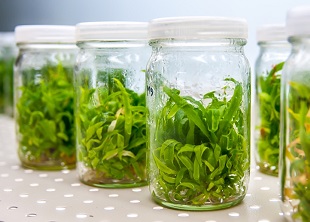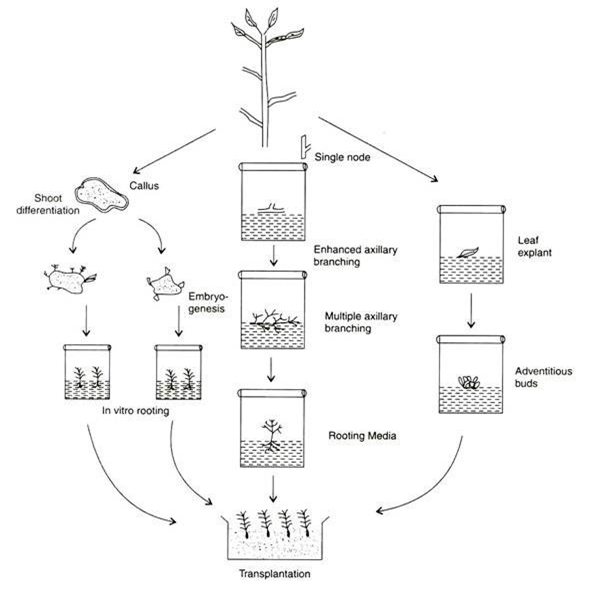In this article we will discuss about:- process of micropropagation and Applications of micropropagation
Micropropagation is a plant tissue culture technique used for production of plantlets, in which the culture of aseptic small sections of tissues and organs in vessels with defined culture medium and under controlled environmental conditions. Or Micropropagation is the technique of multiple production of plants in vitro. It is used for plants that do not produce seeds or respond to normal vegetable reproduction. Briefly, it is the art and science of multiplying plants in vitro.
The process of micropropagation involves 5 distinct stages:
- Stage-0: Identification of elite mother plants/parental material.
- Stage-I: Selection of suitable explants.
- Stage II: Proliferation of shoots from the explant on medium.
- Stage III: Transfer of shoots to a rooting medium.
- Stage IV: Transplantation or hardening
Stage-0: This stage consists of identification of mother plants which should be healthy and explants suitable for establishment in contamination free cultures.
Stage-I: Disease free mother explant is selected for the micro-propagation to reduce contamination of cultures. Explants are: shoot meristem, tip, bud, leaf or stem (internode), root, anther / microspore, ovule and embryo associated seed parts
Stage II: Effective explants from stage I are sub-cultured on to a fresh medium. Cytokinins are adenine derivatives which are mainly concerned with cell division, modification of apical dominance and shoot differentiation in the tissue culture.
Stage III: Shoots proliferated during stage II are transferred to a rooting medium. Auxins are mainly concern with inducing cell division.
Stage IV: Hardening refers to the process of acclimating plants from indoor temperatures to the outdoors.
Advanrage of Micropropagation:
1. Requires relatively small growing space.
2. The technique of micropropagation is applied with the objective of enhancing the rate of multiplication. Through tissue culture over a million plants can be grown from a small, even microscopic, piece of plant tissue within 12 months.
3. Shoot multiplication usually has a short cycle (2-6 weeks) and each cycle results in logarithmic increase in number of shoots.
4. Tissue culture gives propagules such as minitubers or microcorms for plant multiplication throughout the irrespective of the season.
4. Tissue culture gives propagules such as minitubers or microcorms for plant multiplication throughout the irrespective of the season.
5. The small size of propagules and their ability to proliferate in a soil free environment facilitate their storage on a large scale ability to proliferate in a soil free environment facilitate their storage on a large scale and also allows their large scale dissemination by suitable means of transport across international boundries
6. Stocks of germplasm can be main for many years.
7. Pathogen free plants can be raised and maintained economically.
8. Clonal propagation in dioecious is extremely important since seed progently yields 50% females and 50% male plants of one sex are desired commercially. For example, male plants of asparagus officinalis are more valuable then female plants. Propagation by stem cutting in male asparagus is not successful but can be achieved by tissue culture.
Applications of micro-propagation:
• Somaclonal Variation
• Germplasm Conservation
• Mutation Breeding
• Inducing mutation
• Embryo culture
• Haploid and Dihaploid production
• In Vitro Hybridization- protoplast fusion
• Production of Disease free plants
• Molecular farming
• Genetic engineering
• Production of secondary metabolites
Micropropagation Short Notes | Plant Biotechnology
![Micropropagation Short Notes | Plant Biotechnology]() Reviewed by Rajkumar
on
April 23, 2019
Rating:
Reviewed by Rajkumar
on
April 23, 2019
Rating:



No comments: